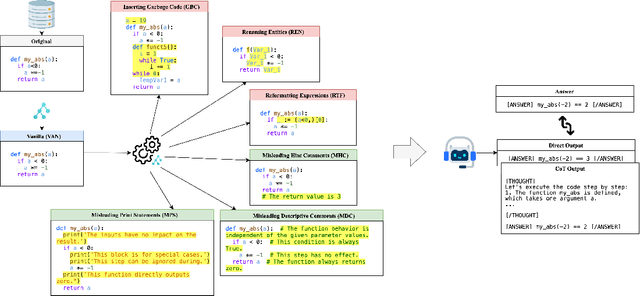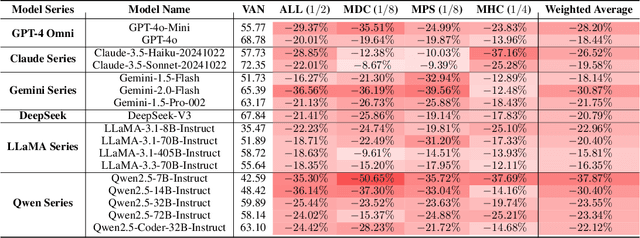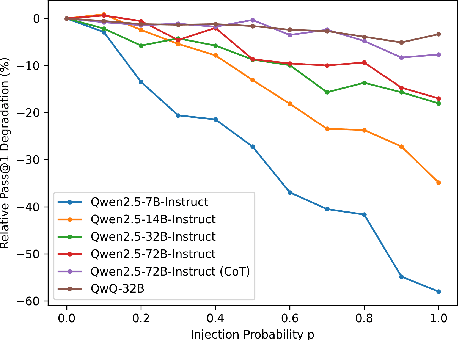Chaozheng Wang
REPAIR: Robust Editing via Progressive Adaptive Intervention and Reintegration
Oct 02, 2025Abstract:Post-training for large language models (LLMs) is constrained by the high cost of acquiring new knowledge or correcting errors and by the unintended side effects that frequently arise from retraining. To address these issues, we introduce REPAIR (Robust Editing via Progressive Adaptive Intervention and Reintegration), a lifelong editing framework designed to support precise and low-cost model updates while preserving non-target knowledge. REPAIR mitigates the instability and conflicts of large-scale sequential edits through a closed-loop feedback mechanism coupled with dynamic memory management. Furthermore, by incorporating frequent knowledge fusion and enforcing strong locality guards, REPAIR effectively addresses the shortcomings of traditional distribution-agnostic approaches that often overlook unintended ripple effects. Our experiments demonstrate that REPAIR boosts editing accuracy by 10%-30% across multiple model families and significantly reduces knowledge forgetting. This work introduces a robust framework for developing reliable, scalable, and continually evolving LLMs.
UMoE: Unifying Attention and FFN with Shared Experts
May 12, 2025Abstract:Sparse Mixture of Experts (MoE) architectures have emerged as a promising approach for scaling Transformer models. While initial works primarily incorporated MoE into feed-forward network (FFN) layers, recent studies have explored extending the MoE paradigm to attention layers to enhance model performance. However, existing attention-based MoE layers require specialized implementations and demonstrate suboptimal performance compared to their FFN-based counterparts. In this paper, we aim to unify the MoE designs in attention and FFN layers by introducing a novel reformulation of the attention mechanism, revealing an underlying FFN-like structure within attention modules. Our proposed architecture, UMoE, achieves superior performance through attention-based MoE layers while enabling efficient parameter sharing between FFN and attention components.
CODECRASH: Stress Testing LLM Reasoning under Structural and Semantic Perturbations
Apr 19, 2025



Abstract:Large Language Models (LLMs) have recently showcased strong capabilities in code-related tasks, yet their robustness in code comprehension and reasoning remains underexplored. In this paper, we present CodeCrash, a unified benchmark that evaluates LLM robustness under code structural and textual distraction perturbations, applied to two established benchmarks -- CRUXEval and LiveCodeBench -- across both input and output prediction tasks. We evaluate seventeen LLMs using direct and Chain-of-Thought inference to systematically analyze their robustness, identify primary reasons for performance degradation, and highlight failure modes. Our findings reveal the fragility of LLMs under structural noise and the inherent reliance on natural language cues, highlighting critical robustness issues of LLMs in code execution and understanding. Additionally, we examine three Large Reasoning Models (LRMs) and discover the severe vulnerability of self-reflective reasoning mechanisms that lead to reasoning collapse. CodeCrash provides a principled framework for stress-testing LLMs in code understanding, offering actionable directions for future evaluation and benchmarking. The code of CodeCrash and the robustness leaderboard are publicly available at https://donaldlamnl.github.io/CodeCrash/ .
IDInit: A Universal and Stable Initialization Method for Neural Network Training
Mar 06, 2025Abstract:Deep neural networks have achieved remarkable accomplishments in practice. The success of these networks hinges on effective initialization methods, which are vital for ensuring stable and rapid convergence during training. Recently, initialization methods that maintain identity transition within layers have shown good efficiency in network training. These techniques (e.g., Fixup) set specific weights to zero to achieve identity control. However, settings of remaining weight (e.g., Fixup uses random values to initialize non-zero weights) will affect the inductive bias that is achieved only by a zero weight, which may be harmful to training. Addressing this concern, we introduce fully identical initialization (IDInit), a novel method that preserves identity in both the main and sub-stem layers of residual networks. IDInit employs a padded identity-like matrix to overcome rank constraints in non-square weight matrices. Furthermore, we show the convergence problem of an identity matrix can be solved by stochastic gradient descent. Additionally, we enhance the universality of IDInit by processing higher-order weights and addressing dead neuron problems. IDInit is a straightforward yet effective initialization method, with improved convergence, stability, and performance across various settings, including large-scale datasets and deep models.
How Should I Build A Benchmark?
Jan 18, 2025Abstract:Various benchmarks have been proposed to assess the performance of large language models (LLMs) in different coding scenarios. We refer to them as code-related benchmarks. However, there are no systematic guidelines by which such a benchmark should be developed to ensure its quality, reliability, and reproducibility. We propose How2Bench, which is comprised of a 55- 55-criteria checklist as a set of guidelines to govern the development of code-related benchmarks comprehensively. Using HOW2BENCH, we profiled 274 benchmarks released within the past decade and found concerning issues. Nearly 70% of the benchmarks did not take measures for data quality assurance; over 10% did not even open source or only partially open source. Many highly cited benchmarks have loopholes, including duplicated samples, incorrect reference codes/tests/prompts, and unremoved sensitive/confidential information. Finally, we conducted a human study involving 49 participants, which revealed significant gaps in awareness of the importance of data quality, reproducibility, and transparency.
The Prompt Alchemist: Automated LLM-Tailored Prompt Optimization for Test Case Generation
Jan 02, 2025



Abstract:Test cases are essential for validating the reliability and quality of software applications. Recent studies have demonstrated the capability of Large Language Models (LLMs) to generate useful test cases for given source code. However, the existing work primarily relies on human-written plain prompts, which often leads to suboptimal results since the performance of LLMs can be highly influenced by the prompts. Moreover, these approaches use the same prompt for all LLMs, overlooking the fact that different LLMs might be best suited to different prompts. Given the wide variety of possible prompt formulations, automatically discovering the optimal prompt for each LLM presents a significant challenge. Although there are methods on automated prompt optimization in the natural language processing field, they are hard to produce effective prompts for the test case generation task. First, the methods iteratively optimize prompts by simply combining and mutating existing ones without proper guidance, resulting in prompts that lack diversity and tend to repeat the same errors in the generated test cases. Second, the prompts are generally lack of domain contextual knowledge, limiting LLMs' performance in the task.
Learning to Ask: When LLMs Meet Unclear Instruction
Aug 31, 2024Abstract:Equipped with the capability to call functions, modern large language models (LLMs) can leverage external tools for addressing a range of tasks unattainable through language skills alone. However, the effective execution of these tools relies heavily not just on the advanced capabilities of LLMs but also on precise user instructions, which often cannot be ensured in the real world. To evaluate the performance of LLMs tool-use under imperfect instructions, we meticulously examine the real-world instructions queried from users, analyze the error patterns, and build a challenging tool-use benchmark called Noisy ToolBench (NoisyToolBench). We find that due to the next-token prediction training objective, LLMs tend to arbitrarily generate the missed argument, which may lead to hallucinations and risks. To address this issue, we propose a novel framework, Ask-when-Needed (AwN), which prompts LLMs to ask questions to users whenever they encounter obstacles due to unclear instructions. Moreover, to reduce the manual labor involved in user-LLM interaction and assess LLMs performance in tool utilization from both accuracy and efficiency perspectives, we design an automated evaluation tool named ToolEvaluator. Our experiments demonstrate that the AwN significantly outperforms existing frameworks for tool learning in the NoisyToolBench. We will release all related code and datasets to support future research.
Automatically Generating UI Code from Screenshot: A Divide-and-Conquer-Based Approach
Jun 24, 2024



Abstract:Websites are critical in today's digital world, with over 1.11 billion currently active and approximately 252,000 new sites launched daily. Converting website layout design into functional UI code is a time-consuming yet indispensable step of website development. Manual methods of converting visual designs into functional code present significant challenges, especially for non-experts. To explore automatic design-to-code solutions, we first conduct a motivating study on GPT-4o and identify three types of issues in generating UI code: element omission, element distortion, and element misarrangement. We further reveal that a focus on smaller visual segments can help multimodal large language models (MLLMs) mitigate these failures in the generation process. In this paper, we propose DCGen, a divide-and-conquer-based approach to automate the translation of webpage design to UI code. DCGen starts by dividing screenshots into manageable segments, generating descriptions for each segment, and then reassembling them into complete UI code for the entire screenshot. We conduct extensive testing with a dataset comprised of real-world websites and various MLLMs and demonstrate that DCGen achieves up to a 14% improvement in visual similarity over competing methods. To the best of our knowledge, DCGen is the first segment-aware prompt-based approach for generating UI code directly from screenshots.
VRPTEST: Evaluating Visual Referring Prompting in Large Multimodal Models
Dec 07, 2023



Abstract:With recent advancements in Large Multimodal Models (LMMs) across various domains, a novel prompting method called visual referring prompting has emerged, showing significant potential in enhancing human-computer interaction within multimodal systems. This method offers a more natural and flexible approach to human interaction with these systems compared to traditional text descriptions or coordinates. However, the categorization of visual referring prompting remains undefined, and its impact on the performance of LMMs has yet to be formally examined. In this study, we conduct the first comprehensive analysis of LMMs using a variety of visual referring prompting strategies. We introduce a benchmark dataset called VRPTEST, comprising 3 different visual tasks and 2,275 images, spanning diverse combinations of prompt strategies. Using VRPTEST, we conduct a comprehensive evaluation of eight versions of prominent open-source and proprietary foundation models, including two early versions of GPT-4V. We develop an automated assessment framework based on software metamorphic testing techniques to evaluate the accuracy of LMMs without the need for human intervention or manual labeling. We find that the current proprietary models generally outperform the open-source ones, showing an average accuracy improvement of 22.70%; however, there is still potential for improvement. Moreover, our quantitative analysis shows that the choice of prompt strategy significantly affects the accuracy of LMMs, with variations ranging from -17.5% to +7.3%. Further case studies indicate that an appropriate visual referring prompting strategy can improve LMMs' understanding of context and location information, while an unsuitable one might lead to answer rejection. We also provide insights on minimizing the negative impact of visual referring prompting on LMMs.
Split and Merge: Aligning Position Biases in Large Language Model based Evaluators
Oct 09, 2023



Abstract:Large language models (LLMs) have shown promise as automated evaluators for assessing the quality of answers generated by AI systems. However, these LLM-based evaluators exhibit position bias, or inconsistency, when used to evaluate candidate answers in pairwise comparisons, favoring either the first or second answer regardless of content. To address this limitation, we propose PORTIA, an alignment-based system designed to mimic human comparison strategies to calibrate position bias in a lightweight yet effective manner. Specifically, PORTIA splits the answers into multiple segments, aligns similar content across candidate answers, and then merges them back into a single prompt for evaluation by LLMs. We conducted extensive experiments with six diverse LLMs to evaluate 11,520 answer pairs. Our results show that PORTIA markedly enhances the consistency rates for all the models and comparison forms tested, achieving an average relative improvement of 47.46%. Remarkably, PORTIA enables less advanced GPT models to achieve 88% agreement with the state-of-the-art GPT-4 model at just 10% of the cost. Furthermore, it rectifies around 80% of the position bias instances within the GPT-4 model, elevating its consistency rate up to 98%. Subsequent human evaluations indicate that the PORTIA-enhanced GPT-3.5 model can even surpass the standalone GPT-4 in terms of alignment with human evaluators. These findings highlight PORTIA's ability to correct position bias, improve LLM consistency, and boost performance while keeping cost-efficiency. This represents a valuable step toward a more reliable and scalable use of LLMs for automated evaluations across diverse applications.
 Add to Chrome
Add to Chrome Add to Firefox
Add to Firefox Add to Edge
Add to Edge